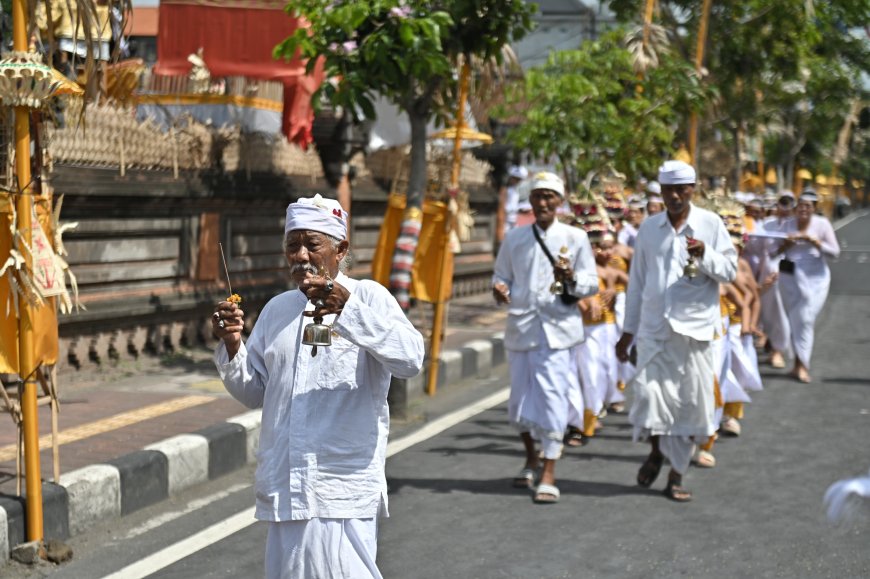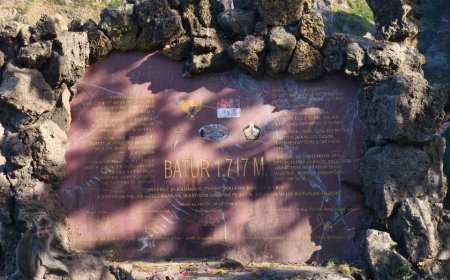Mapepade Agung: A Balinese Ritual Showcasing the Unique Purification of Animals
On October 6, 2024, the village of Dlod Tukad in Batubulan, Gianyar, Bali, held the Mapepade Agung tradition as part of the Karye ceremony. Mapepade Agung is a purification procession for sacrificial animals before they are used in yadnya rituals. The animals are honored and dressed in traditional attire as a symbol of equality. This tradition reflects deep respect for the animals' spirits and the harmonious relationship between humans and nature in Balinese culture.

Mapepade Agung is a sacred tradition in Bali aimed at purifying animals before they are sacrificed in the yadnya ceremony, a holy offering ritual. This tradition carries profound meaning within Balinese culture and spirituality, as it expresses respect and compassion for the spirit of the animals that will be sacrificed. For the Balinese, this tradition is not merely a ceremony but a reflection of the harmony between humans, animals, and the universe.

Animals adorned in traditional attire during the Mapepade Agung procession (Source: Personal Collection)
The term "Mapepade" is derived from the word "pada," which has two main meanings in Balinese: "sama" and "kaki" The first meaning, "sama" conveys the concept of equality, where the animals to be sacrificed are treated with respect, as if equal to humans. This procession represents honoring the animal's soul, with the hope that their spirit may attain a higher form of existence in the next life and not be reborn as animals.
The second meaning of "pada," which refers to "kaki" symbolizes the inclusion of animals with two or four feet, such as cows, goats, chickens, pigs, and even turtles. These animals are considered representations of nature’s diversity, and their presence in the yadnya ritual is a symbol of respect and gratitude for the natural world that sustains life.
In Batubulan Village, particularly at Pura Dalem Delod Tukad, the Mapepade Agung tradition involves various animals, including cows, pigs, goats, chickens, and turtles. The animals are dressed in traditional Balinese attire as a symbol of respect and purification. The traditional dress given to the sacrificial animals reflects human reverence for them as living beings with souls.

Procession of animals around the temple in the Mapepade Agung ceremony (Source: Personal Collection)
During the purification process, these animals are paraded around the temple three times, accompanied by the harmonious and solemn sounds of Balinese gamelan music. This procession acts as a spiritual purification, preparing the sacrificial animals to become part of the yadnya ritual. After three rounds of the temple, the priest blesses the animals and marks them with specific symbols, indicating the blessing and permission to fulfill their role in the ceremony. The animals are then adorned with tridatu bracelets and light markings on their bodies, signifying they have been purified and are ready for the yadnya.

The procession is accompanied by the sounds of gamelan from the seke beleganjur ensemble. (Source: Personal Collection)
In the Mapepade Agung tradition, Sanggar Tawang is a crucial component in the Tawur ceremony, which is part of Bhuta Yadnya. Sanggar Tawang is a sacred elevated place where the Tri Purusa, symbolizing the three aspects of Shiva—Shiva, Sadha Shiva, and Parama Shiva—are enshrined. These three aspects are believed to oversee the yadnya and bless its proceedings. Additionally, Sanggar Tawang serves as the resting place of Ida Bhatara Rare Angon, the deity believed to guide the animal spirits to a higher realm, facilitating their reincarnation into a better life.
The symbolism of Sanggar Tawang as a place where the gods witness the yadnya adds a spiritual dimension to the ceremony. The presence of Ida Bhatara Rare Angon as the protector and guide of the animal spirits signifies that every living being, including sacrificial animals, has its own spiritual journey. This illustrates that yadnya in Balinese culture is not merely a physical sacrifice but an effort to maintain balance between the human world and the spiritual realm.

The priest leads the Mapepade Agung procession.(Source: Personal Collection)
Mapepade Agung reflects the Balinese worldview of harmony between humans, animals, and the universe. In this tradition, people acknowledge that life’s continuity requires balance with nature and all its contents. The animals purified in the yadnya ceremony are treated with love and respect, symbolizing appreciation for the natural world that supports human life. This embodies a philosophy of natural balance, where humans do not hold absolute dominion over animals and plants but coexist within an interconnected life cycle.
The harmony embedded in Mapepade Agung also teaches the importance of gratitude and humility. By purifying and respecting the sacrificial animals, the Balinese are reminded that life is a gift to be appreciated and preserved. This tradition encourages people not to exploit or damage nature excessively but to maintain balance and mutual respect among all living beings.
At the peak of the Mapepade Agung procession, the animals that have been purified are taken to each banjar (village community) for use in the yadnya. Their sacrifice in the yadnya ceremony is part of Bhuta Yadnya, a ritual intended to sustain harmonious relations with nature and spiritual forces. Bhuta Yadnya plays an essential role in maintaining harmony between humans and natural forces, which, in Balinese belief, are represented by Bhuta Kala.

The animals are adorned with rings and bracelets in the ceremonial procession. (Source: Personal Collection)
By offering yadnya to Bhuta Kala, the Balinese believe that nature will become more stable, and balance will be maintained. Mapepade Agung serves as a tangible expression of respect for nature, as an act of gratitude to the natural elements that support human life. In Balinese Hindu philosophy, yadnya represents devotion and service to nature and the gods, as well as a moral responsibility to maintain ecological balance.
In Balinese society, Mapepade Agung holds profound meaning as a reminder of the importance of balance in all aspects of life. Humans do not merely rely on nature but are also responsible for protecting it. Mapepade Agung teaches that humans cannot live without a harmonious relationship with nature and other living beings. By purifying sacrificial animals in the yadnya ceremony, the Balinese emphasize the importance of safeguarding and valuing every form of life, a value that underpins all aspects of their lives.
































































